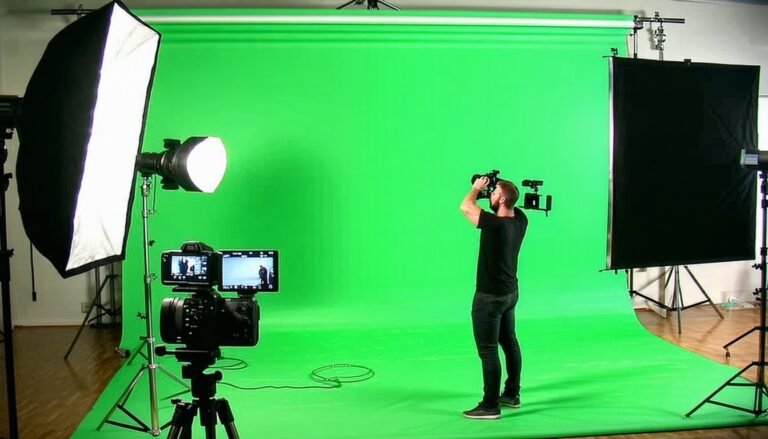If you’re looking for a comprehensive green screen compositing tutorial that guides you through every step of the process, you’ve come to the right place. Whether you’re working on an indie film, a YouTube channel, or your first short film, mastering clean chroma key extractions is an essential skill that will help your footage stand out. Below, you will find an ultimate guide that captures all the essentials, allowing you to create professional-grade composites confidently
Learn the fundamentals
Before diving in, it helps to understand why green screens are so popular. When you shoot footage against a green screen, you can remove (o” “key o “t”) the green background and place your subject in a different environment. This is how big-budget filmmakers and indie creators alike make impossible scenes come to life. However, pulling off a believable composite is not just about color—it involves lighting, distance, camera settings, spill suppression, and careful planning.
- Green is typically used because digital cameras are more sensitive to green light, giving you cleaner edges.
- Blue screens are a great alternative if your actor or subject is wearing green or if you are filming a dark, nighttime scene.
- For more advanced insights, you can explore professional keying techniques.
Plan your shoot
Solid planning is crucial to prevent headaches later. First, evaluate the scene and ask yourself these questions:
- What costume and prop colors are involved?
- What is the overall lighting scenario or setting (outdoor, indoor, low light)?
- How much space do I have to place my subject at a distance from the green screen?
Ensure you have sufficient space on the set so that your subject does not look too close to the background. That extra distance reduces green spill on hair and clothing. Remember, an evenly illuminated background is your best friend for consistent results.
Light your screen
Lighting is one of the biggest reasons composites fail—or succeed. If your green screen is unevenly lit, your keyer will struggle to remove specific areas without also eliminating parts of your subject.
- Use soft, diffused lights on the screen itself to avoid hotspots or shadows.
- Place separate lights on your subject to keep them distinct from the screen. This often means at least two lights for the background and two or more for the subject.
- For a more in-depth guide, explore our green screen lighting setup.
Good lighting elevates your footage from looking “m” h” to looking polished, and it helps you avoid that dreaded toxic-waste-barrel glow around your actor.
Capture your footage
Once you lock in your lighting, it’s time to roll the camera. Here are a few tips to ensure you get the best raw material:
- Shoot in a high-quality format (ideally 4:2:2 or 4:4:4 chroma subsampling) to retain color detail.
- Keep your camera settings consistent to avoid unexpected color shifts.
- Watch out for wrinkles or folds in the backdrop—they create shadows and hot spots.
You will thank yourself later when your shot keys out quickly, and you don’t need to make a million corrective passes.
Start compositing properly
Post-production is where the magic truly happens. The general process goes like this:
- Import your footage and place it below a background layer in your editing software.
- Use a keyer (such as Keylight in After Effects) to remove the green background.
- Fine-tune settings like screen gain, screen balance, and clip black/white to isolate your subject while preserving hair and edges
If you are using Adobe After Effects, you may find our breakdown on keying out a green screen in After Effects helpful. You can also explore the best green screen keying software to compare different tools.
Refine edges carefully
Even with excellent planning and precise keyer settings, pesky green spill can linger. Hair, shiny objects, and reflective surfaces are the usual suspects. Here is how to tackle them:
- Use spill suppression tools, either built into your keyer or as a standalone effect.
- Desaturate or rebalance the edges to neutral tones, rather than letting them remain vibrantly green.
- For fine detail, zoom in close to check for faint halos or crunchy outlines. Make subtle adjustments until the composite looks seamless.
It can be a bit of a dance—you don’t want to turn your subject’s hair gray accidentally or your skin tones dull. Find that sweet spot by toggling between the alpha channel (screen matte) and the RGB view to see exactly what the keyer is removing.
Expand your skills
Green screen compositing is a vital gateway skill in VFX, but it is just the start. Once you master the basics of pulling a clean key, you can explore sky replacements, advanced set extensions, and more complex shot compositions. For next-level tips, you can read more about professional keying techniques.
Above all, keep experimenting. Each shoot is different, and you will discover new creative solutions with every project. Before long, your green screen composites will blend so seamlessly that viewers focus on the story rather than the technique. That is the moment every VFX artist strives for, and I cannot wait to see how you make it happen.
Happy compositing, friend! And if you found this guide helpful, make sure to give yourself a big “THANK Y” U” for taking the time to sharpen your skills. After all, a well-executed composite does so much more than remove a color—it transports your audience to new realities.
FAQS – Frequently Asked Questions
1. What is green screen compositing?
Green screen compositing is the process of layering subjects shot in front of a green backdrop onto new backgrounds during post-production.
2. Why use green screen compositing?
Green screen compositing lets filmmakers place actors or objects in any location or environment without physically being there.
3. How does green screen compositing work?
Green screen compositing works by keying out green pixels and replacing them with digital or photographic backgrounds.
4. What lighting is ideal for green screen compositing?
Even, diffused lighting on the green screen and separate subject lighting ensure smooth green screen compositing with minimal spill.
5. How do I avoid green spill during compositing?
Avoid green spill by lighting the screen separately from the subject and keeping adequate distance between them.
6. Which software is best for green screen compositing?
Popular tools for green screen compositing include After Effects, Nuke, Fusion, and Premiere Pro.
7. What background colors aside from green are used in compositing?
While green is common, blue screens are used for compositing when the subject contains green elements.
8. How important is keying quality in green screen compositing?
High-quality keying is crucial to achieve clean edges and avoid artifacts in green screen compositing.
9. Can green screen compositing work on mobile footage?
Yes, but green screen compositing on mobile requires steady footage, good lighting, and high resolution.
10. What role does color correction play in compositing?
Color correction ensures that the foreground and background match, which is essential for convincing green screen compositing.
11. Do I need a backdrop stand for green screen compositing?
While a stand adds stability, compositing can work with fabric backdrops properly lit and smoothed.
12. What is edge feathering in green screen compositing?
Edge feathering softens the transition between subject and background, enhancing green screen compositing realism.
13. How much space do I need for green screen compositing?
A few meters between subject and screen prevents shadows and spill, which is essential for clean green screen compositing.
14. Can I composite moving subjects with green screen?
Yes, green screen compositing accommodates motion, but you need consistent lighting and well-exposed footage.
15. What is background plate in green screen compositing?
A background plate is the final scene that replaces the green screen during compositing.
16. How do I fix transparency issues in compositing?
Use matte adjustments and spill suppression tools to fix transparency problems during green screen compositing.
17. Can I do green screen compositing on a budget?
Yes, affordable green screen compositing can be achieved with homemade backdrops, LED lights, and open-source keying software.
18. How do I check composition before final render?
Use low-res previews and zoomed-in edge checks to review green screen compositing for artifacts before rendering.
19. What common mistakes occur in green screen compositing?
Common errors include uneven lighting, shadow casting, green spill, and improper color correction.
20. How do I match camera angles in compositing?
Match camera angles using motion tracking and consistent lens settings during green screen compositing.
21. Where can I learn green screen compositing?
You can learn green screen compositing through online courses, VFX tutorials, and hands-on practice with real projects.













